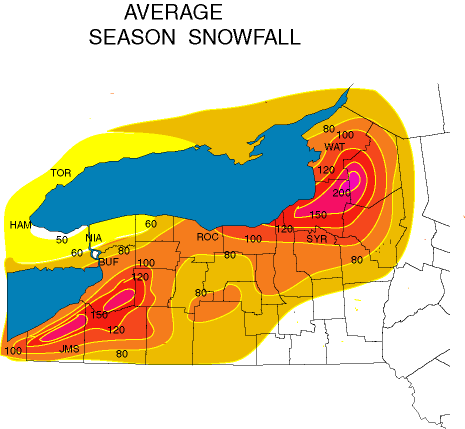“Modern-day Book of Mormon geography scholars appear to be much like the Scribes and Pharisees of the time of Christ. ‘They strain at a gnat and swallow a camel.’ (Matt. 23:24). Those men have completely overlooked the landmarks and the prophecies about the Land of Promise, that land choice above all other lands, found in the Book of Mormon. They make remarks like, ‘There is no mention of the weather.'” (Delbert W. Curtis, Christ in North America, 1993, p. 26)
The “weather card” is a desperate attempt by Mesotheorists to justify their stance that the Western New York model does not contain the true lands of the Book of Mormon. They use current weather conditions as the ruler, and they measure locations as if weather patterns did not change.
In a few score years, we in North America have experienced a variety of weather changes:
- El Niño
- La Niña
- Sunspot Activity
- Volcanic Eruptions
- Ocean Conveyor Belt
- Spontaneous Fluctuations
- Chaos
- Bond Event
- Medieval Warming Period
- Little Ice Age(s)
- Global Warming
- Atmospheric Rivers
“Buffalo logged more days of at least 50% sunshine than Orlando, FL.” (Mike Vogel, “Buffalo is Sunshine Capital of Northeast,” Buffalo News, May 18, 1989, A-1.)
Research shows that the climate changes; some examples are:
Sediments in Piermont Marsh of the lower Hudson Valley show a dry Medieval Warm period from AD 800–1300. (“Marshes Tell Story Of Medieval Drought, Little Ice Age, And European Settlers Near New York City,” Earth Observatory News, May 19, 2005.)
The Medieval period is found to display warmth that matches or exceeds that of the past decade in some regions… The patterns of temperature change imply dynamic responses of climate to natural radiative forcing changes involving El Nino and the North Atlantic Oscillation – Artic Oscillation. (“Global Signatures and Dynamical Origins of the Little Ice Age and Medieval Climate Anomaly,” Science, vol. 326, November 27, 2009, p. 1256)
Around 7000 B.C. climatic conditions in the Northeast were moderating and becoming more arid…Although this broad hypsithermal interval, which persisted until approximately 1000 B.C., was in general warmer than the present, it included alternate phases of thermal maxima and cooler episodes. (William A. Ritchie, The Archaeology of New York State, 1965, p. 16)
An example of extreme weather changes that occurred during the life of Joseph Smith, Jr. was the “Year Without a Summer.”
The “weather card” is hardly a reason to deny the true geographical location of Book of Mormon lands in Western New York. Nonetheless, here are quotes about there being NO SNOW during winter in western New York.
We have already observed that the Cat Nation [Erie, NY] is so called from the large number of Wildcats, of great size and beauty in their country. The climate is temperate, NEITHER ICE NOR SNOW being seen in the WINTER; while in the summer it is said that grain and fruit are harvested in abundance, and are of unusual size and excellence. (Arthur Caswell Parker, “The Archeological History of New York,” vol. 1, New State Museum Bulletin, Nos. 235, 236, July-August 1920, p. 275)
It is RARE TO SEE SNOW in this country (Neuter Nation/Erie County) more than half a foot deep. (O. Turner, Pioneer History of the Holland Purchase of Western New York, 1850, p. 66)
This was due to the mild winter, for even on January 25, 1906, the FARMERS were PLOUGHING. (Joseph William Winthrop Spencer, The Falls of Niagara, Their Evolution and Varying Relations to the Great Lakes; Characteristics of the Power, and the Effects of its Diversion, 1907, p xii-xiii)
Now it is January [1981] in the land of the drumlins. On one of the highest hills, at the top of a country lane called Zoar Road, whitewashed rocks mark a dirt driveway leading to the home of a modern-day Indian family, the Monty Campbell family. Normally at this time of year, snow is so deep that drifts cling to barns and smother trees. But THIS YEAR, SNOWFALL HAS BEEN NEGLIGIBLE. In fact, this morning is LIKE A SPRING MORNING, even though it’s the MIDDLE OF WINTER. (Richard M. Romney, “Zion on Zoar Road” New Era, June 1981)
Lack of Snow North of Buffalo, NY
“In contrast to the tremendous snowfall amounts to the east of the lakes is the lack of snow in parts of Niagara and Orleans counties which are located to the north of Buffalo. This area does not normally get much snow off Lake Erie or Lake Ontario, mainly because it is not downwind of the longer fetch across each body of water.”
“In Erie county, including the city of Buffalo, annual snowfall ranges from less than 80 inches to more than 160 inches over a 15-mile-wide area that is inhabited by nearly 500,000 people!” (“Average Seasonal Snowfall Over the Eastern Great Lakes Region,” Chris Cappella, “Answers: 10 snowiest ‘cities’ aren’t all in New York,” 10/2/2003, USATODAY.com, The Truth About Snow in Buffalo)
Cold Season in the Book of Mormon
The Book of Mormon does mention seasons:
There were some who died with fevers which at some seasons of the year were very frequent…to which men were subject by the nature of the climate— (Alma 46:40)
Herbs cured the seasonal illnesses:
…excellent qualities of the many plants and roots which God had prepared to remove the cause of diseases (Alma 46:40)
This herbal formula is still in use today:

(https://www.amazon.com/Foods-Ojibwa-16-Ounce-Glass-Bottle/dp/B0002JI7D6)
Heat & Fatigue Misinterpreted
Some modelers have misinterpreted the following verse to represent a hot, sweaty, tropical climate:
And it came to pass that when the night had come Teancum and his servant stole forth and went out by night and went into the camp of Amalickiah and behold sleep had overpowered them because of their much fatigue which was caused by the labors and heat of the day. (Alma 51:33)
A contributing factor to that heat was the thick garments they implemented for warfare:
Now the leaders of the Lamanites had supposed because of the greatness of their numbers yea they supposed that they should be privileged to come upon them as they had hitherto done yea and they had also prepared themselves with shields and with breast-plates and they had also prepared themselves with garments of skins yea very thick garments to cover their nakedness (Alma 49:6)
Clothing
They wore little clothing in summer or winter and seemed to thrive. “One Jesuit father who lived among the Mohawk people states that he saw one warrior braving a storm with the upper part of his body bare, and only protected by a wildcat skin through which he had thrust his arm, holding it on the windward side.” These people lived in bark houses, unheated save by the floor fires lighted for cooking.” (James Sullivan, History of New York State, vol. 1, 1927, p. 42)
The weather in the Book of Mormon was such that the people wore multiple layers of clothing. It was not hot, humid, and sweaty like in the tropics of Mesoamerica:
Now this was the covenant which they made and they cast their garments at the feet of Moroni saying we covenant with our God that we shall be destroyed even as our brethren in the land northward if we shall fall into transgression yea he may cast us at the feet of our enemies even as we have cast our garments at thy feet to be trodden under foot if we shall fall into transgression (Alma 46:22)
One could play the “lack of evidence card” against Mesotheorists by asking why aren’t any of the following weather-related events mentioned in the Book of Mormon:
- Volcanoes – smoke, ash, and earthquakes on non-important days; regularly occurring (Guatemala alone has 33 volcanoes; the events at the coming of Christ, i.e., earthquakes, darkness, etc., were “never before known.” [3 Nephi 8:5-7])
- Hurricanes – “Caribbean coast (East Sea) extremely susceptible to hurricanes and other tropical storms.” (CIA World FactBook) Which excludes other models with the Caribbean as the East Sea. Many Nephite cities were along the East Sea, yet storms are never mentioned.
- Tempests
- Flash floods
- Mudslides
- Defensive forts (dirt and wood) falling apart by the rains and floods
- Armies being thwarted by storms like what occurred with Zion’s camp
Fulfilled Land Promises are a more useful and accurate ruler to measure a model’s worth. Something Mesotheorists will avoid at all costs.
